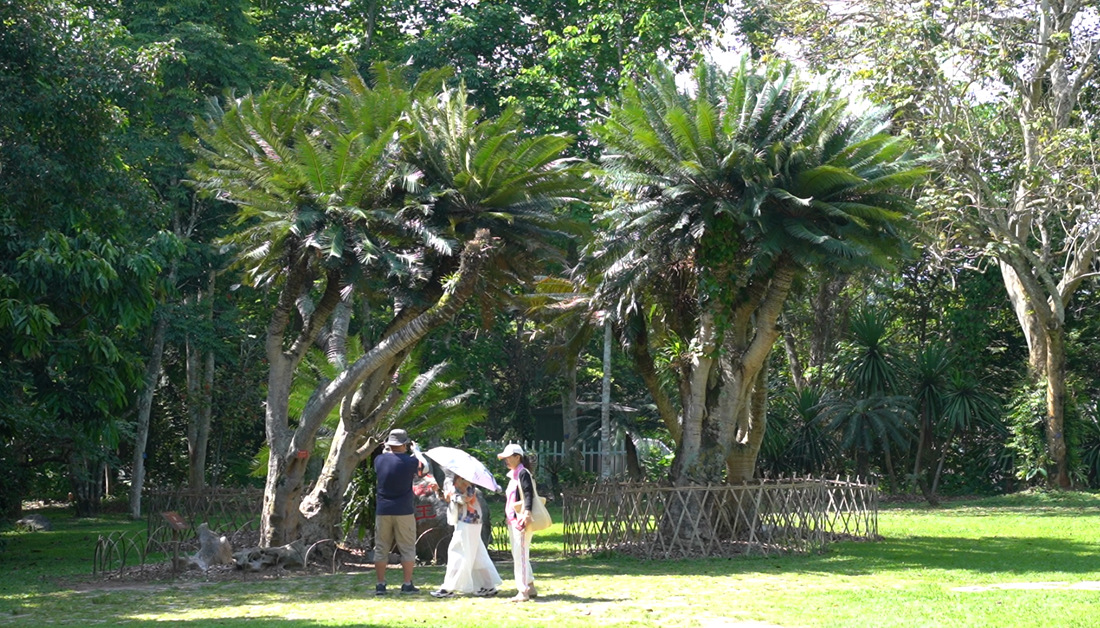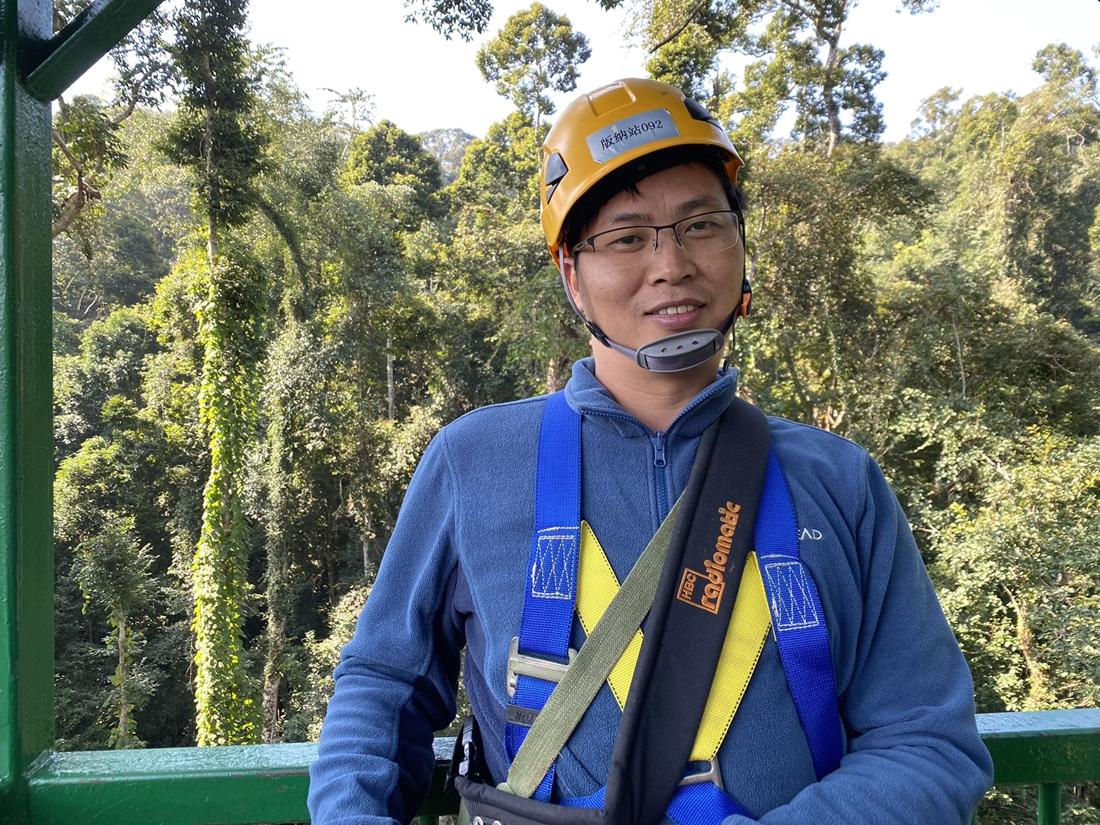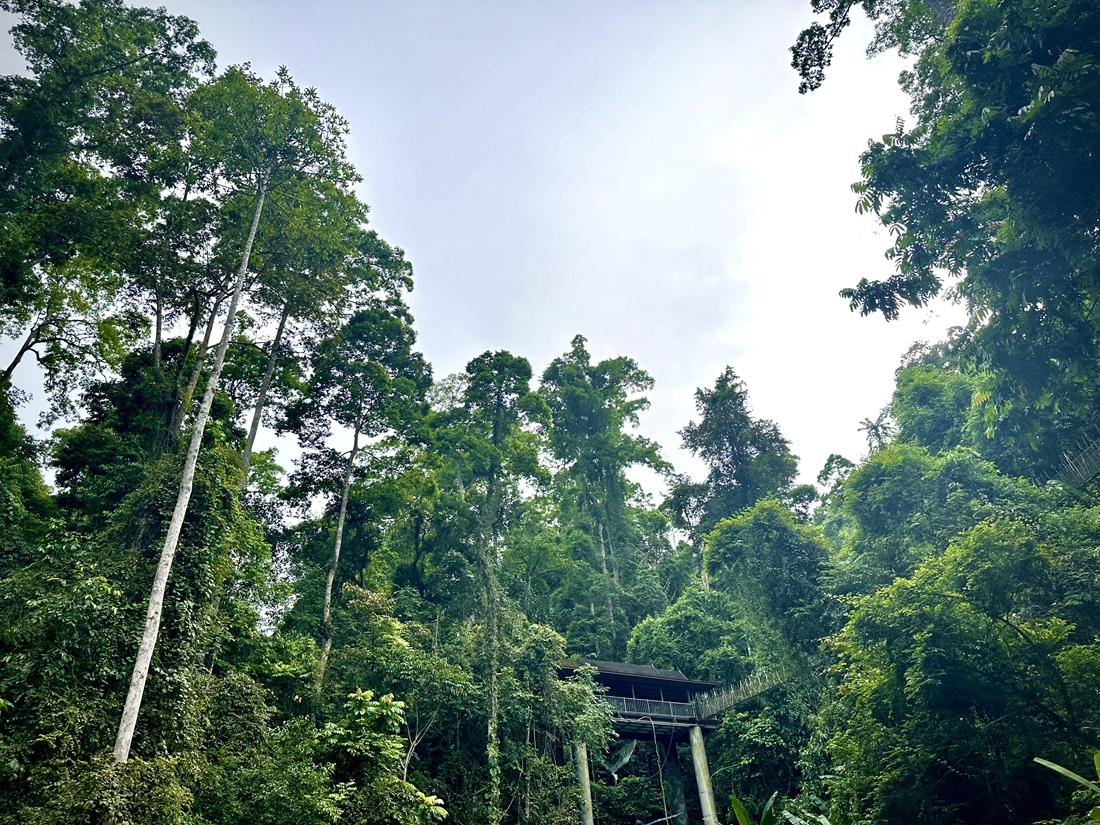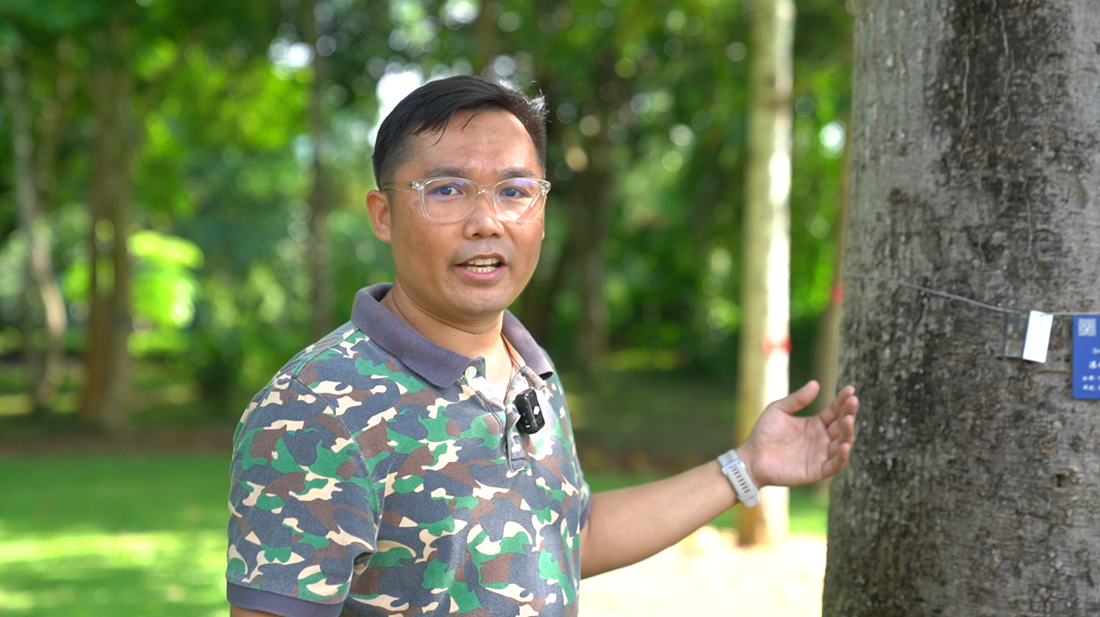Harmonious rhythm of the rainforest in south Yunnan
2024 marked the 50th anniversary of China’s discovery of tropical rainforests, a finding that was shared with the world in 1974. During a field investigation in Mengla County, Xishuangbanna Dai Autonomous Prefecture, Chinese botanists identified the rainforest’s representative species, Parashorea chinensis, from the Dipterocarpaceae family. This discovery confirmed the existence of a rainforest at 21 degrees north latitude. Today, Xishuangbanna Dai Autonomous Prefecture stands as the best-preserved area of China’s tropical ecosystem, showcasing a remarkably beautiful and vibrant rainforest. In this issue of our newsletter, our reporters will take you into the heart of the rainforest to experience its unique rhythms.

Witnessing the blooming of China-Laos friendship
The Xishuangbanna Tropical Botanical Garden, part of the Chinese Academy of Sciences, is one of China’s most diverse botanical gardens, featuring the richest collection of species, the largest number of specialized plant zones, and expansive grounds. In this vibrant setting, exotic flowers thrive and compete for attention.
Kittisack Phoutthavong, a Laotian PhD student and scientist specializing in ferns at the Key Laboratory of Tropical Forest Ecology at the Chinese Academy of Sciences, is committed to conserving tropical rainforest biodiversity. He has playfully adopted the nickname “Bee,” which has led colleagues to affectionately refer to him as “Dr. Bee.”
Following in Dr. Bee’s footsteps, we visited a garden dedicated to Plumeria rubra. Here, the Plumeria rubra displays white, red, and yellow blooms amidst lush green branches, releasing a delicate fragrance. Dr. Bee said that the Tropical Botanical Garden is one of the most significant centers for the collection and conservation of Plumeria rubra in China. In addition to local varieties, a wide range of specimens from around the world have also been introduced and cultivated here.
In the Tropical Botanical Garden, there is a Plumeria rubra tree planted by the state leaders of China and Laos, symbolizing the strong friendship between the two countries.
Chen Fang, an overseas communication officer from Laos, told our reporters, “Plumeria rubra is known as Chamba in Laos, and its flower is the national flower of our country. The Chamba flowers symbolize purity and hope. We have a saying that no matter where you are, seeing Chamba flowers feels like returning home.”
The northern region of Laos shares similar climatic conditions with Xishuangbanna, both boasting rich tropical rainforests. In the Tropical Botanical Gardens, many plants native to Laos can be found, including Spondias pinnata, whose fruits and leaves are commonly used to flavor dishes. Additionally, there is teak, which is prevalent in Laos; it serves as an important construction material, and the reddish sap from its leaves can also be used as a natural dye.
In recent years, the Tropical Botanical Garden has strengthened its collaboration with Southeast Asian countries by establishing the Southeast Asia Biodiversity Research Institute to facilitate cross-border cooperation and joint scientific research. “We have conducted four joint scientific expeditions between China and Laos, assisting the local community in creating a biodiversity map, discovering numerous new species, and training professionals,” said Yang Zhen, head of the Science Communication Team at the Tropical Botanical Garden.
Dr. Bee, a beneficiary of the scientific research collaboration, said passionately, “Laos is home to a wealth of plant species, many of which are yet to be discovered or cataloged. Improving taxonomy and establishing plant genealogies is crucial, and that is exactly what we are working on.”

Tuning in to the voice of a rainforest researcher
Entering the Wangtianshu Scenic Area of Xishuangbanna Tropical Rainforest National Park, the tall and straight Parashorea chinensis stands out prominently in the forest. When in full production, the seeds of these trees swirl elegantly through the air like feathers, revealing a distinctive beauty of nature. Our reporters also discovered a touching story about Dong Jinlong, a researcher, and his connection to the Parashorea chinensis.
Dong, an engineer at the Tropical Botanical Garden, studied biological sciences at Yunnan Normal University. Starting in his sophomore year, he began his journey in scientific plant research under the guidance of Academician Sun Hang from the Kunming Institute of Botany, Chinese Academy of Sciences.
“At that time, I primarily conducted plant surveys and collected experimental samples on the Qinghai-Xizang Plateau, while also participating in the gathering of wild germplasm resources at the Southwest China Wildlife Germplasm Resource Bank,” Dong said. Driven by curiosity and a yearning for discovery, along with his experience in plant classification, he later joined the Xishuangbanna Tropical Botanical Garden. Initially, he focused on plant identification, revising species names, and digitizing plant information. Today, he works at the Xishuangbanna Ecological Station of the Tropical Botanical Garden, where he primarily monitors and researches the Parashorea chinensis rainforest.
Parashorea chinensis, the giants of the forest, reach heights of 70 to 80 meters, making it challenging to observe these tall trees. In 2014, a forest canopy tower crane was built and put into operation in Xishuangbanna. “The tower crane allows researchers to access the forest canopy for non-destructive and repeatable direct observations,” Dong explained. Previously, researchers could only reach the canopy by climbing with a single rope or using ladders and other methods, which had drawbacks — they were not very repeatable and couldn’t cover the entire area effectively. The tower crane overcomes these challenges, ensuring that sample sites remain undisturbed while allowing researchers to observe and study the canopy up close.
“Most of the time, I accompany other researchers to conduct studies using the tower crane, which serves as an open platform not only for our organization but also for ecologists, zoologists, botanists, and other scientists from around the world, facilitating diverse research efforts,” Dong said. “Collaborating and exchanging ideas with researchers from across the globe has greatly broadened my perspective on scientific research.”
“If we didn’t reach the forest canopy, it was difficult to understand the specific form of Dipterocarpaceae plants. Upon reaching the very top, we discovered that Parashorea chinensis could tower over other trees by an extra one or two dozen meters,” Dong said. Previously, human estimates of the height of Parashorea chinensis were often inaccurate. Although they had attempted to measure it using infrared rangefinders and other equipment, achieving precise measurements in such a densely populated forest proved impossible. “It’s only when you reach the forest canopy and measure with a real ruler that you can truly appreciate the majesty of Parashorea chinensis.”
“I once found a black webbed tree frog (Rhacophorus reinwardtii) among the foliage of the Parashorea chinensis canopy. This frog species has been observed and documented as inhabiting the highest habitat in the world. There is still much we don’t understand, such as the conditions of the epiphytes on the forest canopy, but we are slowly unraveling these mysteries,” Dong said. He enthusiastically shared the many surprises that Parashorea chinensis has brought him, yet he is also aware that researchers often face loneliness and challenges in their work. “We are willing to persist out of our love for nature and our reverence for this profession. There are countless unknowns in nature, and we will continue on the path of wonder and discovery,” he added.

Composing new sagas of wild Asian elephants
Asian elephants residing in the tropical rainforest are often referred to as “rainforest engineers.” Xishuangbanna National Nature Reserve is the only habitat for Asian elephants in China, and the “Wild Elephant Valley” within the reserve is the country’s first eco-tourism destination focused on animal and environmental protection. When people mention “Wild Elephant Valley,” they often recall the story of a group of wild Asian elephants that originally roamed this area. In 2021, these elephants traveled north to Yuxi and Kunming, embarking on a journey that lasted over a year before returning home, captivating global netizens who followed their adventure online.
The Asian Elephant Rescue and Breeding Center, situated next to the Wild Elephant Valley Scenic Area, is China’s only scientific research facility dedicated to the rescue and breeding of Asian elephants. In the early morning, a few staff members from the center were accompanying an elephant into the depths of the valley, where tall vegetation towers above and sunlight filtered through the lush forest, creating a tapestry of dappled light. “Wild Asian elephants are seen more frequently from December to February each year. At this time of year, they typically hide deep within the rainforest,” a staff member said.
The center has rescued numerous elephants, including Longlong, who was abandoned by the herd due to an injury; Yangniu, who suffered from a congenital disease; Qiangqiang, an orphaned calf; Pingping, whose hips were severely infected and inflamed; and Wizhayo, who showed a volatile temperament and repeatedly blocked roads to steal food, causing damage to passing vehicles. Each of these elephants has faced significant challenges and danger in their lives.
In their daily work, the staff members are responsible for checking the elephants’ physical condition, feeding them, cleaning up their droppings, and providing rewilding training. They spend over 10 hours a day with the elephants. Through their time together, the staff have come to be affectionately known as “Elephant Dads,” a title that embodies both their responsibility and care for these animals. Chen Jiming is a seasoned “Elephant Dad” who has been working in Wild Elephant Valley for 16 year. “The rescued baby elephants lack their mothers to care for and guide them, so they require a lot of attention from us. For instance, Yangniu was once poisoned after mistakenly eating mandarins,” Chen shared.
In April 2018, a 12-year-old wild elephant named “Abao” wandered into the downtown area of Pu’er City, moving through a crowded space. To ensure the safety of both citizens and the elephant, Abao was anesthetized and transferred to the rescue center, where he underwent four years of behavior modification and rewilding training. In July 2022, it was decided to begin an experiment aimed at returning Abao to the wild. The “Elephant Dads” took Abao to the wild rearing area every day, allowing him to forage for food and live in a natural environment, which helped him regain his wild instincts and survival skills.
At 6 PM on May 17, 2024, the staff members opened the gate to the fenced rewilding training area. Just ten minutes later, Abao stepped out and made his way into the depths of the rainforest. “This is the first time in China that a rescued wild elephant has undergone rewilding before being released back to nature,” said Wang Bin, director of the Xishuangbanna Asian Elephant Protection and Management Center. “I hope Abao will successfully integrate into an elephant herd and one day return with his own offspring.”
The stories of the Asian elephants living in the Xishuangbanna rainforest are still unfolding. With the growing awareness of ecological protection and increased wildlife conservation efforts, these elephants are set to expand their range deeper into the rainforest. This journey will not only represent the survival and reproduction of wildlife but also serve as a vivid illustration of the harmonious coexistence between humanity and nature.

Youth power needed to protect the tropical rainforest
More people are seeking to connect with nature and appreciate the beauty of biodiversity. The tropical rainforest in Xishuangbanna serves as a vital destination for those looking to immerse themselves in nature, offering an outdoor paradise and a natural classroom for tourists.
Nowadays, the Tropical Botanical Garden is bustling with visitors from early morning, with electric tourist vehicles weaving through the garden, creating a vibrant scene. Guests often pause beneath the towering ancient trees to capture the perfect interplay of light and shadow in nature or gather around the enchanting dancing grass (Codariocalyx motorius) to witness its leaves waving in time to the rhythm of singing. Many visitors follow professional tour guides to delve deeper into the mysteries of plant growth, while others take a hot air balloon ride for a breathtaking aerial view of this lush ecological kingdom, enjoying an unparalleled visual feast.
Unlike parks, plantations, and purely scientific research institutions, botanical gardens provide visitors with the opportunity to appreciate scenic beauty while also playing a vital role in science education. Understanding nature is the first and essential step toward protecting biodiversity. The Tropical Botanical Garden’s three main missions—scientific research, species preservation, and science popularization—still have a long way to go. Yang Zhen and Dr. Bee agree that only by fostering public engagement with plants and enhancing understanding, we can inspire more meaningful actions for conservation.
In recent years, the Tropical Botanical Garden has hosted numerous interactive activities for the public, including night tours, naturalist training camps, and rainforest naturalist camps, bringing together nature enthusiasts. Additionally, the garden has invited leading scholars in the fields of plants, insects, and birds, along with science communication experts, to guide visitors deep into the rainforest in search of wildlife. These efforts aim to share knowledge and foster a greater understanding of nature among a wider audience.
Tropical rainforests, sometimes referred to as green deserts, are particularly fragile and face significant threats. Dr. Bee advocates for their protection and has chosen to continue his work at the Tropical Botanical Garden. “Urban young people seldom have the opportunity to connect with nature. I hope we can create conditions that allow them to learn more about the species on our planet and the crucial role plants play in the ecosystem, ultimately inspiring them to become stewards of the rainforest and protectors of biodiversity,” he said.
Text by our staff correspondents
Translated by YNTA